Home / Compare Electricity & Ga… / How to read your electri…




Key takeaways
Energy bills can often read like a road map. However, if you want to stay on top of your household budget, it’s an important skill to have. We’ll outline the key features you should look out for when reading your energy bill to help minimise the confusion.
- While electricity and gas bills will typically look different to each other, the essential information on each bill is usually the same.
- When reading the meter details of your bill, you should check whether it’s an estimated or actual bill, as estimated meter reads may have you paying more than you need.
- If you use Liquified Petroleum Gas (LPG) to power your gas appliances, you won’t always have a gas plan and receive bills from a retailer. However, it’s still important to understand how to read your LPG bills.
Expert tips for choosing the right energy plan
Our Head of Energy, Meredith O’Brien has some top tips on helping you choose a suitable energy plan for your needs.

Consider different energy retailers if you use electricity and gas
You don’t need to use the same retailer (also known as an energy provider) for your gas and electricity. In fact, you may be able to find cheaper options by signing up to plans with different providers.
Add your bills details when you compare
Remember to have you bill on hand when you do your comparison and input your bill details. This will give you a better idea of what you’re likely to pay for gas or electricity, assuming you use the same amount each billing period.
Understand your electricity meter
Getting to know your electricity meter may help you better understand your electricity usage and change your energy usage habits.
Essential information on how to read your electricity and gas bills
The essential information can usually be found at the very top of your energy bill. It usually includes details regarding your:
- Account reference number
- Account name
- Tax invoice number
- Date of the bill and billing period
- Supply address
- Retailer’s phone number
- Distributor’s phone number.
You’ll need these basic account details and account number on hand if you want to discuss your energy plan, bill or account details with your energy retailer, which you can only do if you’re the primary account holder, joint account holder or named authorised contact (although there may be varying degrees of access to information).
The supply details, including the property address and billing period, will also be outlined in this section, as well as the details of the energy plan you’re on. If the supply address is your business location, keep a copy of the invoice filed away for taxation purposes.
Your retailer’s contact information should also be listed on the bill to discuss any general queries or lodge complaints. You can also contact your distributor (whose name and contact number are also listed on the front page of your bill) to report any faults or emergencies affecting your energy service.
With the roll out of the Better Bills guide, retailers are also now obliged to let you know the best plan they can offer you every 100 days (or every quarter if you’re in Victoria).
Energy retailers buy energy from energy generators, package it into plans and sign customers up to them. Distributors are responsible for delivering energy and connecting homes and businesses to the grid.
How often do you pay electricity bills in Australia?
Electricity bills in Australia are typically charged quarterly, but many retailers also offer monthly payment options. Depending on your retailer, you could get a monthly billing plan on a basic meter, but your monthly bills will be estimated until your retailer’s quarterly reading. Based on this reading, you’ll either owe the difference between your estimated bills and your actual metered usage or be credited for the additional electricity you’ve paid for.
Sample electricity bill
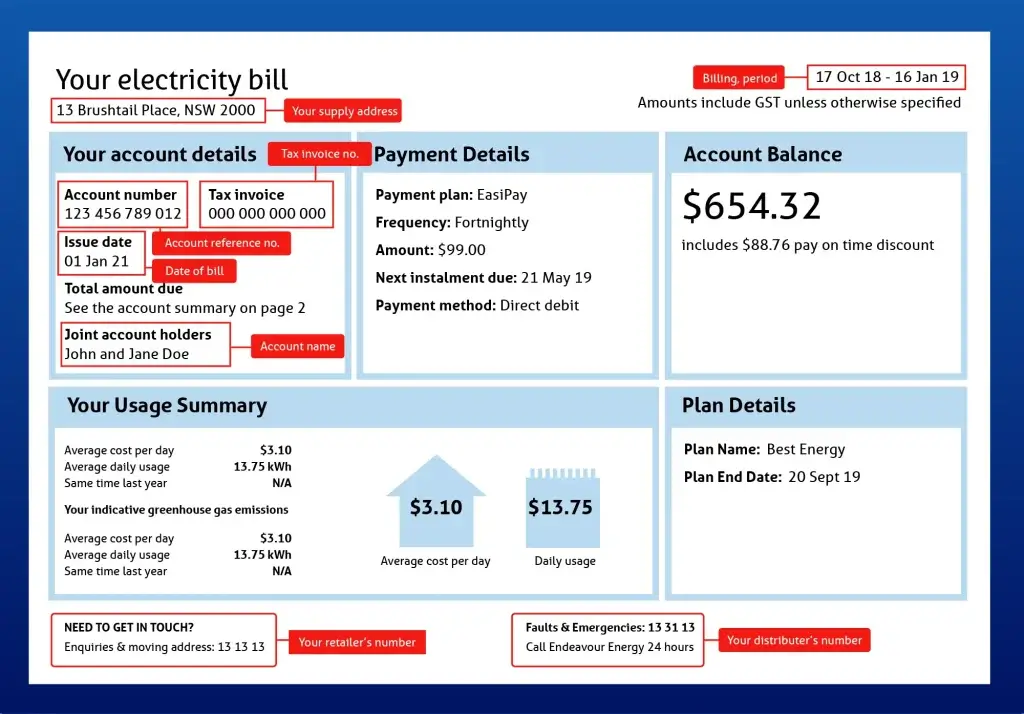
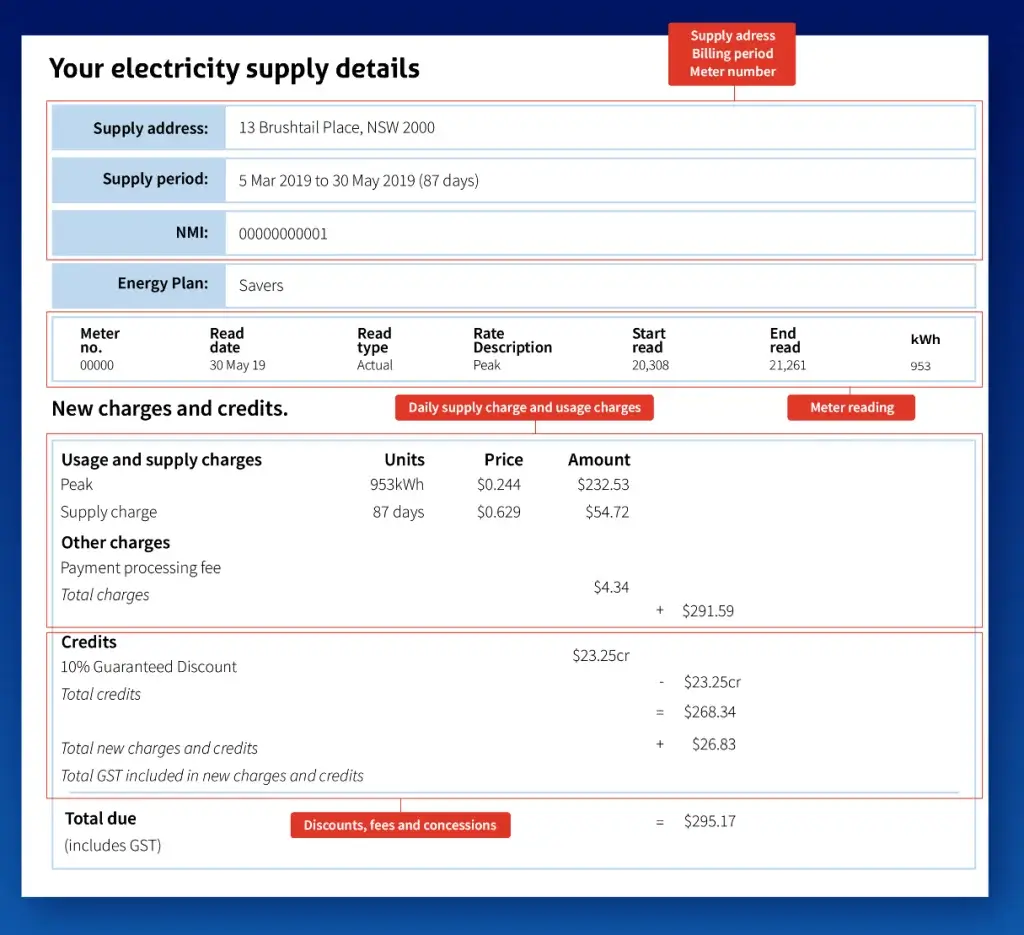
How to read your electricity bill
Usage costs
Charges for your electricity bill are broken down into various structures and rates. The section of your bill that details your usage costs will normally be broken down into two subsections: meter details and usage calculation.
Meter details
The meter details will outline:
- Your supply address
- Your meter number (National Metering Identifier [NMI])
- Billing period (number of days you’re charged for)
- Meter reading (the billing period covered and whether it’s the actual or estimated read).
Estimated bills take into account your past energy consumption and calculate an amount based on previous bills and other factors. Estimated bills may be issued if your meter reader can’t gain access to your property to provide an actual read of your electricity meter or based on the type of meter you have, as a basic meter is typically only read on a quarterly cycle. Some retailers allow you to submit your own meter reading to receive an actual bill. There are three types of electricity meters that can measure your power usage: electricity basic meter, electricity interval meter and smart meter. So, keep in mind that the type of meter you have will also affect your bill.
Usage calculation
This section of the bill will explain how your energy bill has been calculated. It will outline:
- Daily supply charges, which is the cents per day charged for the property to be connected to the grid for electricity. If your electricity meter is active, this will be charged regardless of whether you use any electricity at the time.
- Usage charges, which is the cents per kilowatt-hour (kWh) for the amount you use for electricity.
Your retailer will calculate the usage charges, which could be one or more different types of charges, and different retailers will call these different names.
In each row of your bill calculation table, you’ll be able to see the amount of energy you’ve used and how much you’ve been charged for each applicable rate during that bill period. The total amount due (including GST) is the full amount you owe for that billing period for your energy usage.
Usage charges
No matter what charging structure your energy plan is (also known as tariffs) you’ll see a charge line item on your bill referred to as “peak usage”, “peak consumption” “general usage”, “flat rate consumption” etc. You may not see other charge types, however, as it will depend on the type of tariff you’re on.
Peak (general usage, flat rate, single rate)
If you’re on a flat or single rate electricity tariff, you’ll be charged the peak rate for all your energy use, regardless of when throughout the day or night you used it.
If you’re on a variable tariff, the rates will vary based on the time-of-day energy has been used – often referred to as a time of use tariff. The peak rate is charged for electricity usage during the busiest times of the day when demand for electricity is highest (e.g. in the mornings and evenings when everyone is usually at home). Peak times can also vary depending on the day of the week, your location, and your energy provider.
Off-peak
A reduced rate is charged for electricity usage during quieter times when demand is low. For example, 10pm-6am on a weekday or all-day Sunday may be considered off-peak.
Shoulder times
The rate that covers the gap between peak and off-peak times for a time of use tariff.
Demand
A charge for the level of demand a household or business has on the network for a specified period of the day. This is usually charged during the busiest time of the day when everyone is using electricity (e.g. 2pm-8pm).
A demand charge is applied on top of your normal usage and supply charges and is intended to encourage households to use less energy during peak demand times.
Controlled load
An electricity supply for specific appliances, such as hot water systems and underfloor heating, are separately-metered at a lower rate. These appliances are often used during off-peak times (e.g. overnight) and are typically large, energy-guzzling systems, so a controlled load tariff ensures that their energy usage doesn’t inflate your standard home bill.
Discounts, fees and concessions
Located below the meter details and usage on your bill, you’ll find any discounts, fees and concessions or rebate (if applicable) that may help you save on your electricity bill. Some common items in this category may include:
- A guaranteed discount, which doesn’t require you to meet any specific conditions and is applied to your electricity account during a specified benefit period.
- A conditional discount may be applied if you meet certain eligibility criteria, such as paying your bill on time.
- Rebates for eligible concession card holders.
- A sign-up bonus (or credit) is a once-off incentive or loyalty credit (e.g. $50 for staying with the retailer for 12 months).
- Government rebate is a lump sum or regular credit that may be applied to your electricity bill to assist with cost-of-living expenses.
- A credit card fee, for paying your previous bill via credit card.
If you’ve recently moved to a new house, there may be a connection fee added to your first bill. This is a one-off fee charged by the distributor for connecting power to the property or conducting a first meter read. If you’ve switched plans or retailers since your last bill, you won’t be charged for this as your home will already have been connected.
If you have solar, the solar feed-in tariff (is a rate that is credited to your account for exporting excess electricity back to the grid) will also be included in this section. This will be reflected as a credit on your electricity bill.
Sample gas bill
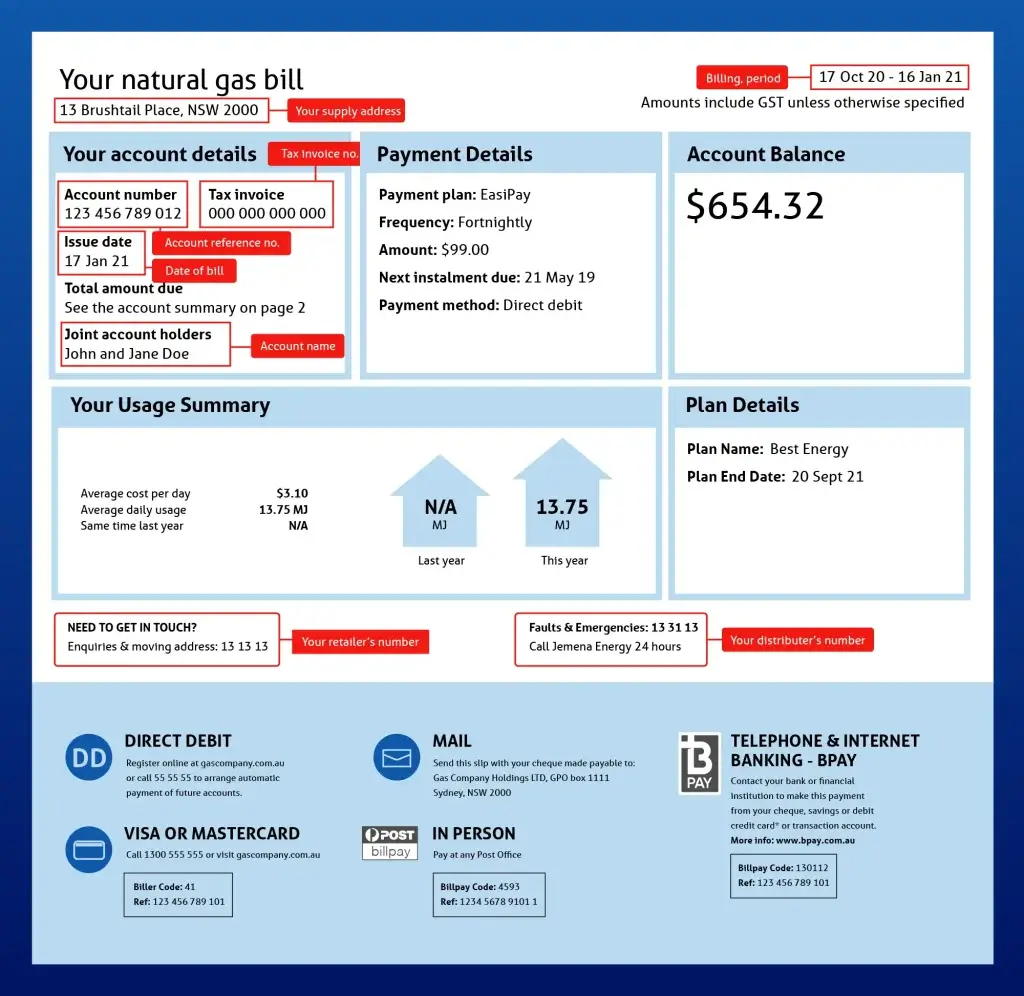
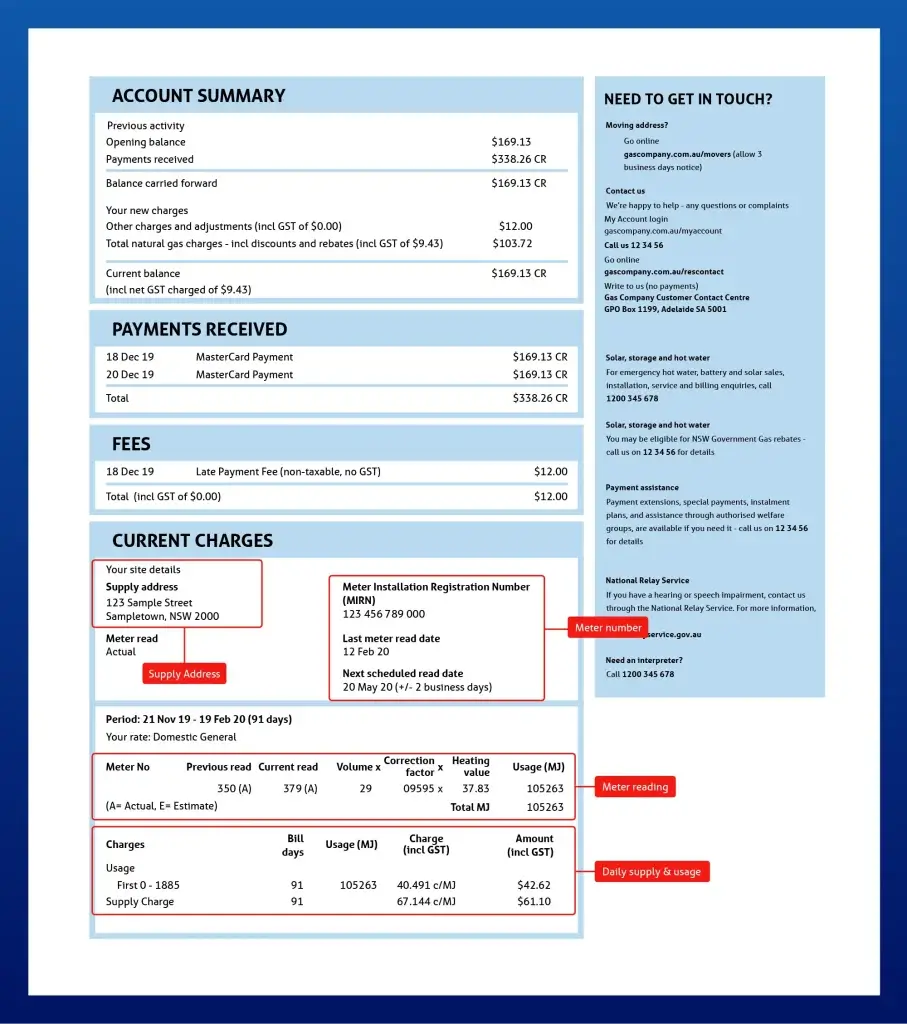
How to read your gas bill
Usage costs
With a natural gas bill, your usage will be calculated in megajoules (MJ), or units if you live in Western Australia. Natural gas bills are detailed in the much same way electricity bills are, but we’ll break down a typical natural gas bill and how LPG differs from being connected to the pipeline.
When it comes to learning how to read your gas bill, first understand that charges are broken down by structures and rates. The usage costs section of your bill is typically split into two subsections: meter details and usage calculation.
Meter details
The details of your meter will include:
- Your supply address
- Your gas meter number (Meter Identification Reference Number [MIRN])
- Billing period (total number of days charged)
- Meter reading (the billing period covered and if it’s an estimated or actual meter read).
Like with electricity bills, estimated bills are usually only issued if your meter reader can’t gain access to your property to read the gas meter.
There are two types of gas meters that can measure your power usage: a metric meter or an imperial meter. A metric meter (also known as a digital meter) records gas usage in cubic meters, while an imperial (or clock face) meter measures in cubic feet. Find out how to read your gas meter here.
Usage calculation
This section on the bill will outline how your retailer calculated your charges. It will contain:
- Daily supply charges. This will detail the cents per day you’re charged for your residence to be connected to the gas pipeline. While you’re connected, the daily supply charge applies even if you don’t use any gas.
- Usage charges. This is the cents per MJ (or unit if you live in WA) for the amount you use for gas.
Unlike an electricity bill, a natural gas bill has only two types of usage that can be charged: flat rate charges – which is the same rate per MJ used; or a block rates – which are a tiered structure of rates that are sold in blocks of MJ, and generally reduce with the higher amount of gas used.
In your bill calculation table, the rows will show your total gas usage for the billing period and the amount your retailer has charged you for each applicable rate during that time. The amount owed for your gas usage in that billing period is known as your total amount due (includes GST).
Usage charges
Depending on which distribution zone you live in, your gas bill may have either seasonal (sometimes referred to as winter and summer rates) or non-seasonal rates.
Non-seasonal rates
On a non-seasonal (single rate) gas tariff, you may be charged at the same rate for all of your gas usage, regardless the day or season. Most gas plans will involve block rates, which is a tiered pricing structure that generally reduces in price per block of gas used during a billing period, at varying rates.
Seasonal rates
If you’re in the Multinet or Ausnet distribution zones of Victoria, you will be charged at higher rates in winter, as the demand for gas is usually higher in winter. In addition, retailers typically charge a reduced rate for gas usage during the summer period.
Discounts, fees and concessions
Beneath the meter details and usage charges are any discounts, fees and concessions (if applicable). These may vary depending on your state, retailer and payment methods but can include:
- A guaranteed discount, which is applied automatically during any specified benefit periods and does not require meeting any conditions.
- A conditional discount if you meet certain eligibility criteria, like paying by direct debit.
- Rebates for eligible concession card holders.
- A sign-up bonus, once-off incentive or loyalty credit (e.g. $100 credit for signing up to a new energy retailer).
- A credit card fee, for paying via credit card.
If you’ve recently moved to a new house, there may be a connection fee added to your first bill. This is a fee charged by the distributor for turning on the gas to your property. If you’ve switched plans or retailers since your last bill, you won’t be charged for this as your home will already have been connected.
LPG bills
Keep in mind that the type of gas you use will affect your energy bill. If you have an LPG cylinder gas system that gets delivered to your home, you’ll pay as needed when you order a new cylinder instead of getting a regular bill.
LPG bills won’t have the same sections or items listed as an electricity or natural gas bill because they’re charged by bottle and not by usage. Your bill may also include an administration of maintenance charge for the delivery and installation of your new bottle(s) and removal of the empty bottle(s). Alternatively, your bottle(s) may be refilled at your property, depending on the size and type of service you have.
A typical LPG bill may look like this:
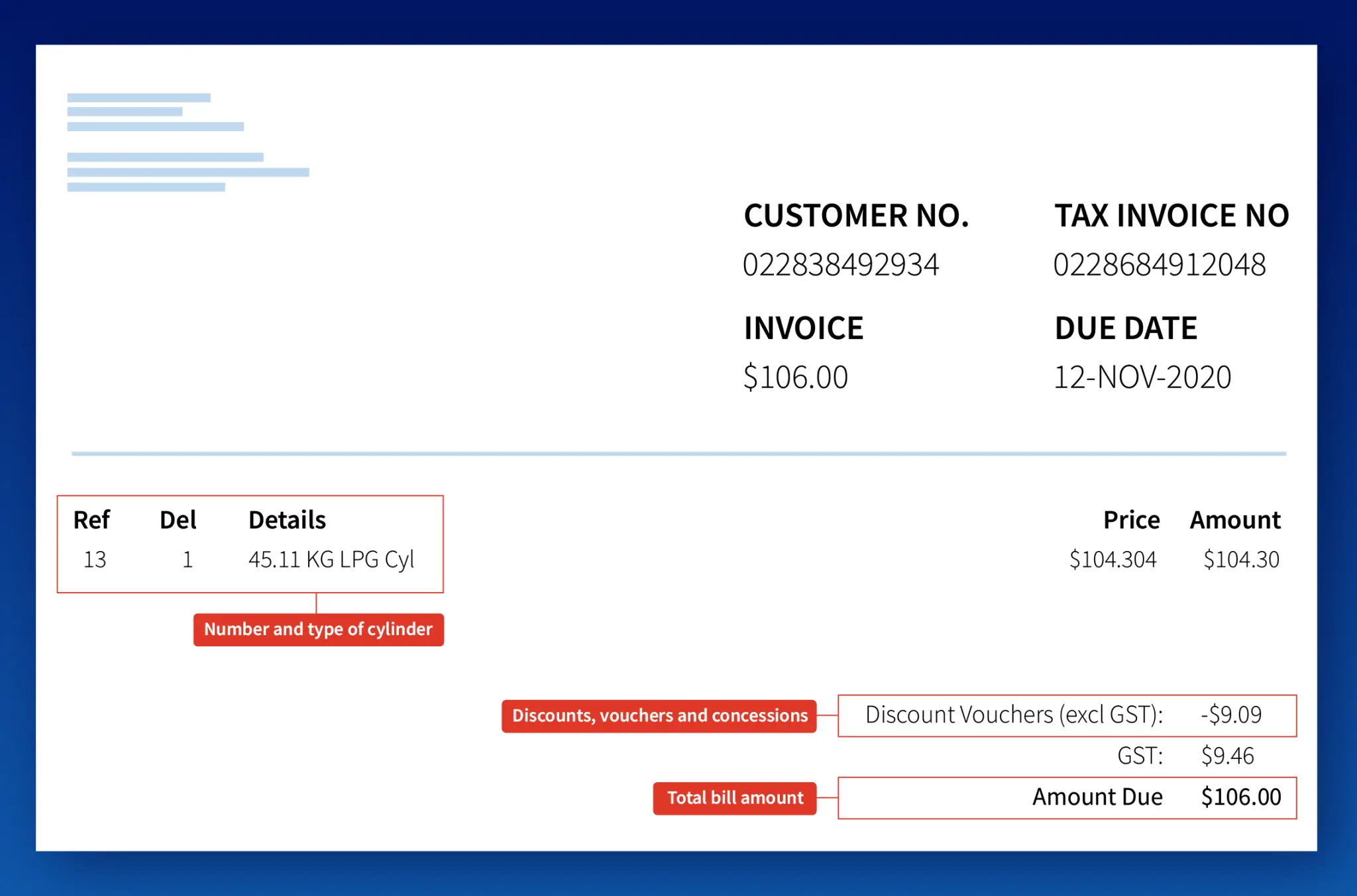
Payment details
In the payment details, you’ll find important information like the total bill amount, which is usually highlighted in bold on the front of the bill. Next to it, you’ll also find the due date and additional conditions (if applicable); for example, you may have a payment plan set up with your retailer as a part of an additional condition.
It’s important to take the time to review your bill and ensure there are no discrepancies or issues prior to the payment date.
If there are no additional conditions, payment options can be found at the very bottom of the same page (commonly referred to as a payment slip). BPAY biller codes, direct debit, credit card, mail and pay in person at an Australia Post office are all common payment options.
There should be instructions on how to pay your energy bill, and you can always call up your energy retailer if you’re having trouble or have any specific queries. Keep in mind that if you’re paying with a cheque, you’ll have to cut off and send this section off with your cheque.
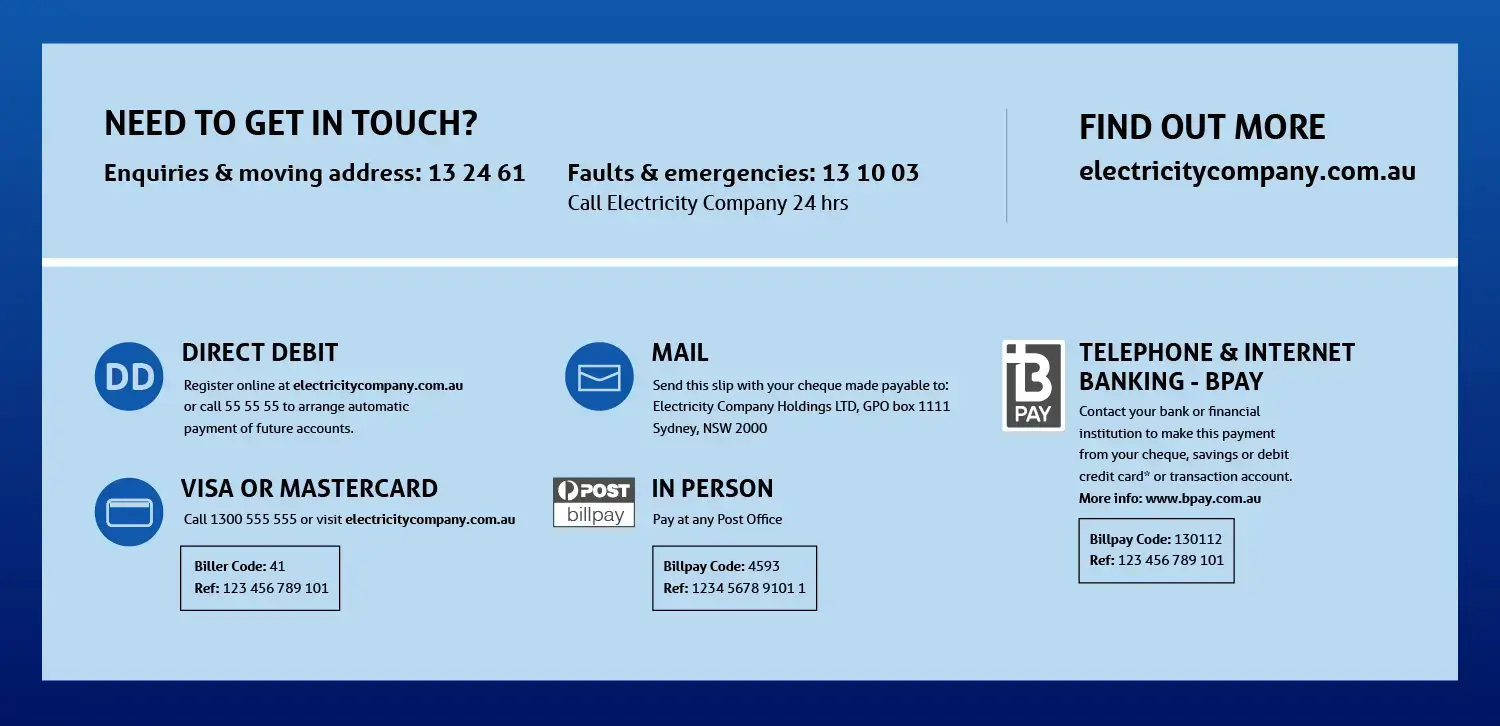
Meet our energy expert, Meredith O’Brien
As the Head of Energy at Compare the Market, Meredith O’Brien believes in educating Australian customers about the everchanging gas and electricity market so they can adjust their energy usage habits and get the most out of their energy plans.
Meredith has six years within the energy industry, following 15 years of experience in financial services and is currently studying a Master of Business Administration. Meredith is a dedicated customer advocate who is passionate about empowering Australians to find the right products to suit their needs by removing the confusion from comparing.

